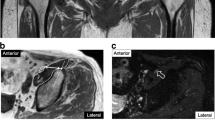Abstract
Background
Nutrient artery canals of the femur are often visible on plain radiographs as radiolucent lines which may mimic fracture lines. The purpose of this study was to distinguish nutrient artery canals from fracture lines on plain radiographs.
Materials and Methods
Ninety-three patients (102 hips) with an average age of 65.6 years were included in the study. We retrospectively analyzed nutrient artery canals of the femur on pre and postoperative anteroposterior (AP) and cross-table lateral (CTL) hip radiographs in patients with cementless total hip arthroplasty. The shape, number, location, direction of obliquity, length of nutrient artery canal, and the distance between the tip of the greater trochanter and the proximal end of the nutrient artery canal were measured.
Results
Nutrient artery canals were determined in 54 hips (53.0%) on preoperative radiographs. The numbers of nutrient artery canals were entirely found to be one for each hip. The nutrient artery canals of the femur were the most frequently seen in the cortex on CTL radiographs with 32 hips (31.4%), whereas nutrient artery canals were not seen at all in the cortex on AP radiographs. All nutrient artery canals in the cortex on CTL radiographs coursed upward obliquely. Comparing to fracture lines, nutrient artery canals show less radiolucency, smaller diameter, and blunted ends in both the cortex and medullary cavity, show sclerotic walls in the cortex and have the less straight course in the medullary cavity.
Conclusions
Based on the results of this study, there are clearly distinguishable differences between nutrient artery canals of the femur and fracture lines on plain radiographs.
Similar content being viewed by others
References
Cohen EM, Vaughn JJ, Ritterman SA, Eisenson DL, Rubin LE. Intraoperative femur fracture risk during primary direct anterior approach cementless total hip arthroplasty with and without a fracture table. J Arthroplasty 2017;32:2847–51.
Fleischman AN, Schubert MM, Restrepo C, Chen AF, Rothman RH. Reduced incidence of intraoperative femur fracture with a second-generation tapered wedge stem. J Arthroplasty 2017;32:3457–61.
Gümüsburun E, Yücel F, Ozkan Y, Akgün Z. A study of the nutrient foramina of lower limb long bones. Surg Radiol Anat 1994;16:409–12.
Kizilkanat E, Boyan N, Ozsahin ET, Soames R, Oguz O. Location, number and clinical significance of nutrient foramina in human long bones. Ann Anat 2007;189:87–95.
Ichimura K, Kinose S, Kawasaki Y, Okamura T, Kato K, Sakai T. Anatomic characterization of the humeral nutrient artery: Application to fracture and surgery of the humerus. Clin Anat 2017;30:978–87.
Owers KL, Leaver AA, Bannister GC. The optimal depth for femoral cement insertion in total hip replacement. An anatomical and clinical study into cementing technique in the proximal femur. Hip Int 2002;12:135–8.
Naldemir IF, Guclu D, Baki Altınsoy H, Berk Canga H, Onbas O. Accessory occipital suture mimicking fracture in head trauma. Am J Emerg Med 2018;36:530.e7-530.e8.
Yuce I, Pirimoglu B, Polat G, Sade R, Emet M, Kantarci M. A sesamoid ossicle of the nuchal ligament mimicking spinous avulsion fracture. Spine J 2016;16:e39.
George CL, Harper NS, Guillaume D, Cayci Z, Nascene D. Vascular channel mimicking a skull fracture. J Pediatr 2017;181:326–0.
Lee JH, Ehara S, Tamakawa Y, Horiguchi M. Nutrient canal of the fibula. Skeletal Radiol 2000;29:22–6.
Imre N, Battal B, Acikel CH, Akgun V, Comert A, Yazar F. The demonstration of the number, course, and the location of nutrient artery canals of the femur by multidetector computed tomography. Surg Radiol Anat 2012;34:427–32.
Macchi V, Regoli M, Bracco S, Nicoletti C, Morra A, Porzionato A, et al. Clinical anatomy of the orbitomeningeal foramina: Variational anatomy of the canals connecting the orbit with the cranial cavity. Surg Radiol Anat 2016;38:165–77.
Murlimanju B, Prashanth K, Prabhu LV, Chettiar GK, Pai MM, Dhananjaya K. Morphological and topographical anatomy of nutrient foramina in the lower limb long bones and its clinical importance. Australas Med J 2011;4:530–7.
Bridgeman G, Brookes M. Blood supply to the human femoral diaphysis in youth and senescence. J Anat 1996;188 (Pt 3):611–21.
Lindhardt FE. Clinical experiences with computed radiography. Eur J Radiol 1996;22:175–85.
Johnson V, Beckett S, Márquez-Grant N. Differentiating human versus non-human bone by exploring the nutrient foramen: Implications for forensic anthropology. Int J Legal Med 2017;131:1757–63.
Tannast M, Siebenrock KA, Anderson SE. Femoroacetabular impingement: Radiographic diagnosis – What the radiologist should know. AJR Am J Roentgenol 2007;188:1540–52.
Schiessel A, Zweymüller K. The nutrient artery canal of the femur: A radiological study in patients with primary total hip replacement. Skeletal Radiol 2004;33:142–9.
Capello WN, D’Antonio JA, Naughton M. Periprosthetic fractures around a cementless hydroxyapatite-coated implant: A new fracture pattern is described. Clin Orthop Relat Res 2014;472:604–10.
Raghavan K, Jeffrey RB, Patel BN, DiMaio MA, Willmann JK, Olcott EW. MDCT diagnosis of perineural invasion involving the celiac plexus in intrahepatic cholangiocarcinoma: Preliminary observations and clinical implications. AJR Am J Roentgenol 2015;205:W578–84.
Longia GS, Ajmani ML, Saxena SK, Thomas RJ. Study of diaphyseal nutrient foramina in human long bones. Acta Anat (Basel) 1980;107:399–406.
Sendemir E, Cimen A. Nutrient foramina in the shafts of lower limb long bones: Situation and number. Surg Radiol Anat 1991;13:105–8.
Nuvvula S, Bhumireddy JR, Kamatham R, Mallineni SK. Diagnostic accuracy of direct digital radiography and conventional radiography for proximal caries detection in primary teeth: A systematic review. J Indian Soc Pedod Prev Dent 2016;34:300–5.
Tam HH, Bhaludin B, Rahman F, Weller A, Ejindu V, Parthipun A. SPECT-CT in total hip arthroplasty. Clin Radiol 2014;69:82–95.
Author information
Authors and Affiliations
Corresponding author
Rights and permissions
About this article
Cite this article
Yun, H.H., Choi, G.W., Kim, W.T. et al. Differentiating Nutrient Artery Canals of the Femur versus Fracture Lines in Patients with Total Hip Arthroplasty on Plain Radiographs. IJOO 53, 622–629 (2019). https://doi.org/10.4103/ortho.IJOrtho_171_18
Published:
Issue Date:
DOI: https://doi.org/10.4103/ortho.IJOrtho_171_18




